#i am literally eyeballing scale depictions over here
Explore tagged Tumblr posts
Text
Some centaurs for the reboot. Only peeps I like enough for that because I’m that way.
~~
Kevin Levin- all deer all the time, leans heavy on moose, fur brown when young but near-black when grown, ears for days (damn those mule deer genes), 11 yo size: 5′6 at head, 3′2 at shoulder, ~250 lbs, adult size: 8′3 at head, 5′6 at shoulder, ~850 lbs
Maxine Sez- pronghorn/antelope cross, golden-brown back fur with white belly and sides, white patches at the throat and ringing the eyes, dark stripe down the front of the legs, 6′0 at head, 3′4 at shoulder, ~200 lbs
Ryan Sez- 75% antelope 25% pronghorn, leans heavily springbok, black color morph with chocolate brown fur and a black dorsal stripe, light brown patches at throat, curved horns with single branch, 14 yo size: 5′3 at head, 2′6 at shoulder, 7in horn length, ~156 lbs, adult size: 5′6 at head, 2′9 at shoulder, 16in horn length, ~190 lbs
Simon Sez- 75% antelope 25% pronghorn, leans heavily springbok, standard coloration of light brown back and sides with brown dorsal stripe and white belly, white patches at throat, will grow curved horns with single branch, 6 yo size: 2′10 at head, 1′2 at shoulder, ~40 lbs, adult size: 5′5 at head, 2′10 at shoulder, 17in horn length, ~190 lbs
Hex- very old, Megalotragus priscus, hartbeest-esque build, wildebeest proportions, dark brown fur, pale brown rump, black striping at shoulders, horns sweep sideways from the top of the head before curving forward, 7′9 at head, 4′9 at shoulder, ~22in horn breadth, ~9in forward sweep, ~645 lbs
Smythe- all horse all the time, strawberry roan, pale body w/ red points, speckles, mane, and tail, 8′2 at head, 5′4 at shoulder, ~1200 lbs
Mary Jo Fourfeathers- very deer primarily of the mule variety, grey-brown furred, ears for days, fur longer than is normal, 5′3 at the head, 2′7 at the shoulder, ~200 lbs
Penny Bennyson- very mule, bay, 7′2 at head, 4′4 at shoulder, ~940 lbs
#i love the tennysons of the reboot too of course but#i love the contrast between them as kev even more#so they suffer with just being human#the hex numbers are estimates because nobody will be so kind as to just give me straight numbers#i am literally eyeballing scale depictions over here#the height they can give me some fucking horn measurements no that would be too kind#also made up some coloration#look let me live i'm trying to do something cool for the bastard#i did him last and it's a good thing because it's killed me
10 notes
·
View notes
Text
Persephone and Phosphenes
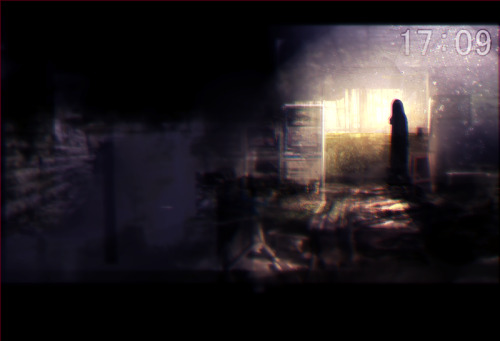
A phosphene is a ring or spot of light produced by pressure on the eyeball or direct stimulation of the visual system other than by light. While the symbolic meaning of the title is not immediately apparent at first the heavy V14 parallels in the current situation, there is a parallel in Kaneki who had pressure specifically applied to his eyes by Arima.
What does this mean for Touka tough? Read under the cut below.


Which is a pretty iconic and well remembered scene from V14. It was even referenced again by Arima later in chapter 8. There are a lot of possible symbolic meanings for seeing a sudden ring of light. Rather than pick a specific one I am going to attempt to float them all. Light in the darkness, false light (and all that symbolizes, probably a false hope to attach to in a hopeless situation) your mind imagining light where it is not, light you only see with your eyes in the absence of true light. light seen after the darkness of being in the 24th ward for too long.
The image itself which preludes the poem depicts a nondescript woman standing in a darkened room where the light also obscures her face as well as most of the room. There is also a time code in the corner “17:09″ which indicates that this woman is likely being filmed by security camera. This, in line with the contents of the poem itself seems to suggest that the woman is being held prisoner. Possibly in a cozier room than most prison cells considering the room itself while bleak does not look barren.
That and the actual content of the poem, while the drawing itself looks like a long haired woman such as Rize, after reading the poem it’s most definitely Touka. From this point forward I am going to go forward in my interpretation that this poem is about Touka, and also hints that the next arc will likely feature a kidnapping rather than a death of Touka rather than holding her prisoner at the CCG.
The first sentence pretty much confirms that is it Touka.
If behaving like a god is a sin, even the act of creating life would be blasphemous. Wouldn’t doing this be mocking the gods?
(If behaving like a god is a sin), could either refer to Kaneki or Furuta, perhaps both. The two of them are elevated onto the same stage above everybody else as king, and the two of them both have been referred to gods of death before this point as well.
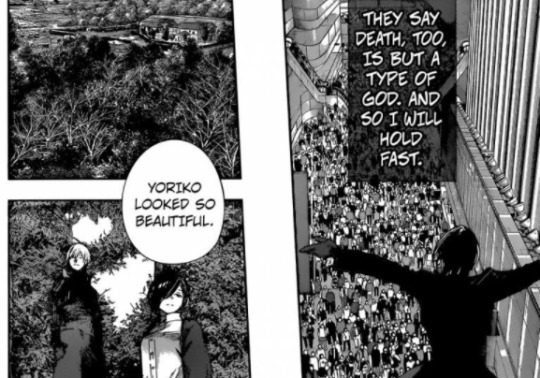
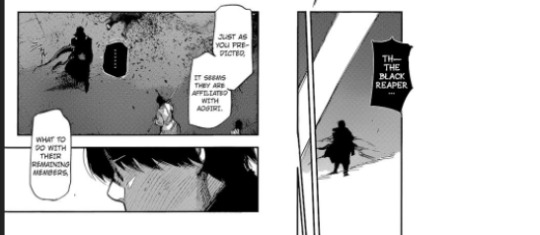
Touka then, as Kaneki’s female counterpart refers to her own act of creating life to be a sin. This references both her previous poem, that is extremely bleak about the process of creating life and parenthood in general. It’s even entitled ‘Her Womb Smelled Like It Was Burnt’. I wrote a meta on it here [x].
The children who were meant to be born, died. The vision of the future convulses.
[...]
“Did you know that our voice is the mixed voices from dad and mom? No wonder it’s so disgusting.”
There are a few other parallels between the two poems, so I’m going to continue to reference it. The fact that creating life for Touka might be forbidden also refers to the taboo that is creating life between a human and a ghoul.
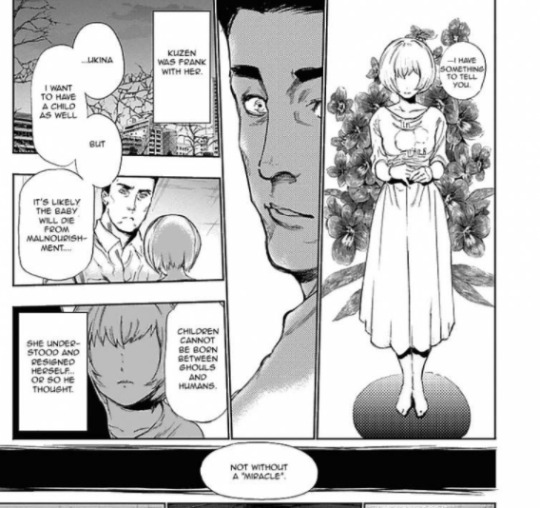
Ukina is explicitly referenced as creating a miracle when her child is allowed to survive. Miracles are god’s domain after all.
Wanting to be judged, I entered the prison of my own free will. I play around with sludge in a silent room. “So you’ve come back again,” I was being cursed at with a timbreless voice.
The line heavily parallels another line from ‘her womb smelled like it was burnt’.
Sin is irresponsible. I’m getting tired of being forgiven. My shoulders have even forgotten about my legs.
‘I am tired of being forgiven’ and ‘Wanting to be judged’ are remarkably similiar lines. These are possibly referring to Touka’s own mental state post Anteiku raid, her feeling that she actually did deserve to be judged just as her world came crashing down on her the same way that Koma and Irimi were.
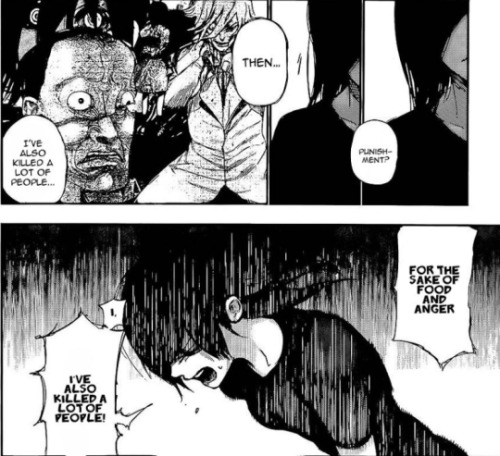
There’s also the idea of Touka entering her cage willingly which, I am going to be floating a few possible interpretations with this poem because I am not entirely sure whether the poem is meant to be figurative or literal, but in a metaphorical sense you could call Touka’s emotional repression and her tendency to over forgive her willingly walking into her own cage. Here is a meta about Touka’s emotional repression [x] and here is a meta about the tendency and symbolism of the 4th ward and it’s occupants willingly walking into their own cages [x]. I am going to reference both of these meta lightly, but try to stick to the main topic of the poem.
Touka has been pictured, being in a room with prison like doors before due to the bare nature of the 24th ward hideout’s construction. This could be a bit of foreshadowing as well as just a symbolic theme for that particular chapter.
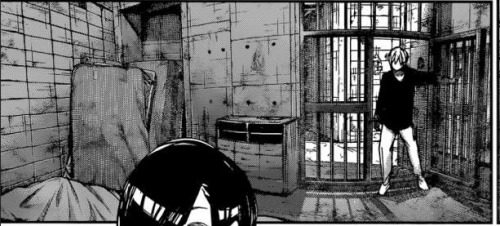
The next passage is what I will build up most of my theory off of. The following passage, especially the italicized part heavily resembles ‘eat the food of the underworld and you are trapped there’ which is once again tied to the myth of Persephone being abducted to the Underworld by Hades, and then eating three seeds from the pomegranite and being forced to stay there.
That place was dazzlingly beautiful. I was starving to death, and then from when I was gnawing on someone’s body, that’s right, from that moment, it all became strange. There definitely have must have been poison in there. Only beautiful merely to the eye, and shit.
I don’t want to put anything in my mouth, I don’t want to hear anything. I don’t want to see anything, anything at all.
Tumblr user @floppyamon pointed this out quite a long time ago that V14′s events, a god of death coming down in a field of flowers heavily resembles the greek myth ‘The Abduction of Persphone’.
Especially since Tatara’s flashback reveals that all along, Arima’s intention in V14 had been to snatch away Kaneki.

The myth of Persephone and Hades begins as such. Persephone is shown playing in a field of flowers, oblivious, until the god of death comes to snatch her away. Persephone was a spring goddess of new life, who often gave away flowers quite easily.
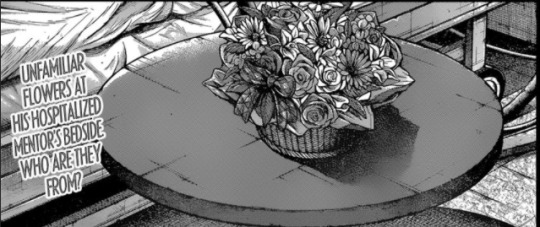
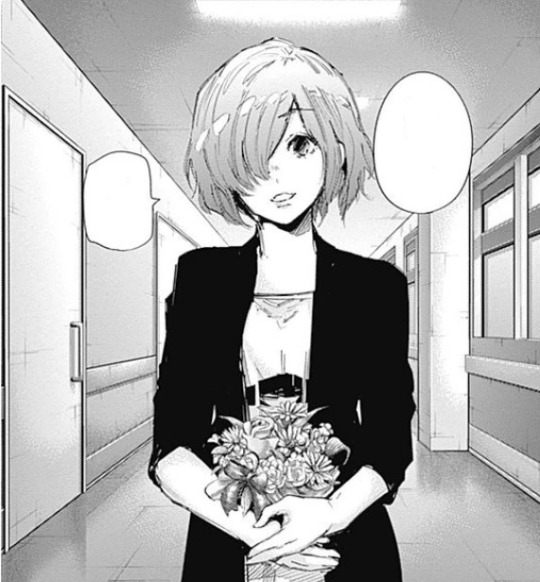
It’s likely no coincidence that Touka is revealed to be the one giving away flowers, on the same chapter that Juuzou referred to as a god of death appears standing before her suddenly and unexpectedly in a flower field.
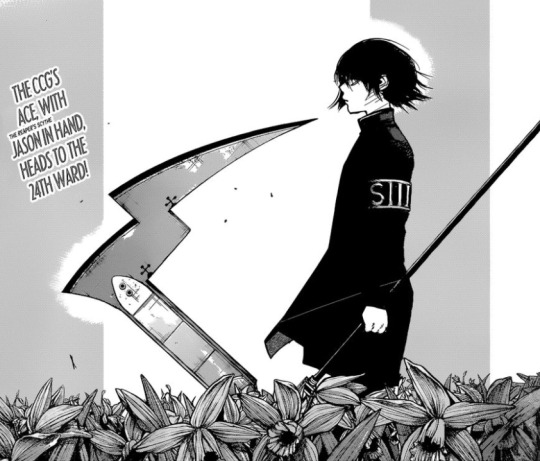
He’s also compared directly with the barely mortal Arima, which could either mean that he was on the brink of dying, or that he was immortal seeming and godlike, both of which connect to the idea of a god of death.
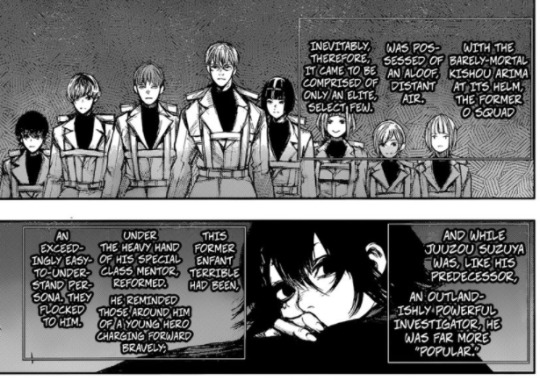
So we have the utlimate v14 parallel here, the god of death appears before Kaneki not to kill him, but to snatch him away. In E14 then, the real danger is not Touka’s death but rather her being snatched away by yet another god of death.
There is of course the second part of the Persephone myth. That once she is in the underworld, she cannot leave because she ate the food of the dead.
I was starving to death, and then from when I was gnawing on someone’s body, that’s right, from that moment, it all became strange. There definitely have must have been poison in there. Only beautiful merely to the eye, and shit.
In the legend Persephone is so upset at her kidnapping at first, she refuses to eat and drink. This is quite similiar to the way Touka has been starving herself and eating human food recently.

This also connects with a theory purported primarily by @midnight-in-town that Touka’s current method of saving the baby will not be sufficient, and eventually she will be introduced to either Itori or Kanou in order to help along her pregnancy. Which goes with my own theory of the clowns being the ones to interfere in the Goat raid and save it at last second when it seems that all hope is lost.
However, that is not the only possible path this could take. It could also be Juuzou deciding to call ownership rights on Touka and spare her, bringing her back to the CCG. Either route I say Touka will likely surivve, but be in the hands of the CCG by the end of this arc. This might even be our introductory to a sunlit garden arc and the full reveal of how exactly the Washuu were crossbreeding children.
As to the food of the underworld, it’s likely the CCG’s labs and resources will better be able to take care of the baby. Hinami made a reference to Soup, which is what the prisoners eat and likely what Touka might be fed eventually too after starving herself for so long.It’s also likely what Sasaki ate while he was in the CCG that gave him enough RC Cells to reverse the fast aging that turned his hair white.

If the CCG had the resources it would likely be able to feed Touka something that would be able to keep her child alive, but that’s also the trap in itself. If Touka would want to keep her child alive she would be unable to leave. Just like how Persephone was unable to leave the underworld when in she ate the fruit of the underworld.
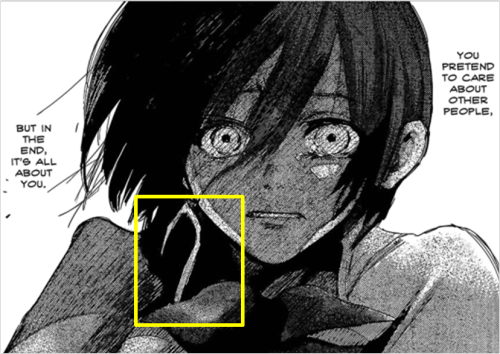
Touka Kirshima’s associated tarot card is the high priestess. The fruit depicted in the background of the High Priestess card itself is the pomegranate, a reference to the Hades and persphone myth.

Place myself on a scale, along with the things being sold off, along with the ripped-apart bodies given away in pieces, along with playing by peeling off scabs, don’t, don’t.*
Throw away everything you don’t need out the window. It’s okay if you fall and die. Until the very end, lend your ears to just the sounds fading away.
Hey, how many things did you get that you wanted?
The last part of the poem is where I assume it becomes the most symbolic. The reference to throwing everything away, and giving body parts away piece by piece could be yet another reference back to the poem Her Womb Smelled like it Was Burnt.
Falling down, falling down. It’s as if right has become left.
And on the brink of collision, I recall Björk’s song,
As for a Bjork song, most assume that song is Hyperballad, the song played during the New Year’s livestream. The lyrics are a bit abstract, but basically it is about a girl throwing away things off a mountain, pieces of herself so she can be happy with someone else. At some point in the song she also considers throwing herself off of the mountain too.
Every morning I walk towards the edge And throw little things off Like car-parts, bottles and cutlery Or whatever I find lying around It's become a habit A way to start the dayI go through all this Before you wake up So I can feel happier To be safe up here with you
Which could reference of course, Touka’s completely willingness to forgive every offense that the CCG does unto her and her family, in hopes that she can live in peace like the promise of Anteiku originally gave to her. Consider how much already Touka has sacrificed for the world, her future amibitions at college, her job at Anteiku, not one but two cafes, and now at the moment her only small want is to have a child with the man she loves, her dreams scaled severely back as the two of them are not even living on the surface right now but even then the CCG had come from them. Which is what possibly the last line of the poem is referring to “How many things, did you get what you wanted?” For Touka then it would be nothing as she sacrificed everything and still had nothing to show for it. It reminds me of the despair in Tatara’s death as well. The CCG will take everything from you if you are a ghoul and they will never stop.

Which is what makes Touka’s insistence on humanizing and forgiving investigators so strange to me. Especially when she’s not really willing to see the moral gray in the situation represented by her own father Arata.
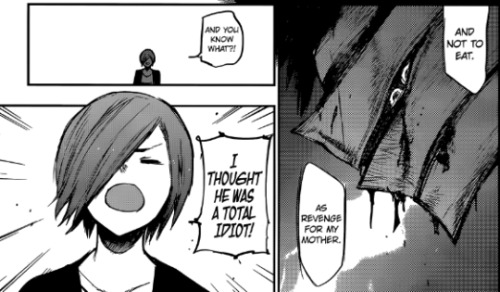
She can’t forgive her father, but she can forgive the man who stripped her father’s skin off repeatedly over the years and wore it like armor in order to kill her surrogate father and destroy her newfound place of home without really one shred of remorse or even seeing ghouls as human beings?
Shinohara was capable of a lot of things, but possible empathy towards ghouls was not one of them. It’s the same with Kuroiwa, they bought the party line too easily because it fit their lifestyles and they fit the frame of a CCG investigator too much.
This isn’t really about Touka’s own passivity and her over selflessness though, which is often something I write about, but rather her attitude in this. Touka has always been deeply ashamed of her identity of a ghoul, something passed on to Touka subconsciously from her father ironically enough. What Touka wants, similiar to what Kaneki wants is to blend into human society seamlessly, even to the point of self harm. In the sense of eating human food in front of Toriko even when she does not have to is an act of self harm, but also that discarding her identity as a ghoul is self harm in a metaphorical way, harm of her identity.
So it makes sense she would forgive Shinohara and see the complexity in his situation, but not her father. Just as in Kaneki’s mind, humans are just simply more human in her mind and more deserving of that complexity than ghouls. Which is where you get the irony in Touka and Kaneki’s mindset, that the two of them are leading a rebellion to destroy society, but what they want more than anything else is to be accepted and comforted by society, even to the point of conformity.
Touka’s never spoken about the ghoul world in a positive light or something worth saving. She seems incredibly uninterested with the rebellion of the one eyed king as a whole, and only invested in supporting Kaneki in it because he is Kaneki.
So that’s what this latter section of the poem is referring to, Touka’s own conformity, her offering up pieces of herself for society in the hopes that she’ll be more acceptable.
It could also refer to the revelation of the Arata armor.
Place myself on a scale, along with the things being sold off, along with the ripped-apart bodies given away in pieces, along with playing by peeling off scabs, don’t, don’t.*
What is described here sounds much like the making of quinques too. The way that ghouls and their dead are treated, like objects to be made and sold for the profit of the CCG.
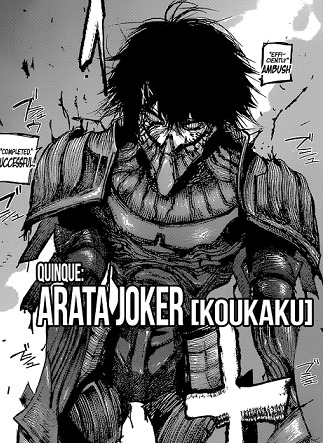
It’s likely that both the sight of her father being worn as armor, and also Kanou treating her baby more like an object of scientific interest rather than a person could bring out a revelation in Touka that there is no reasoning with, and no forgiving certain things the CCG has done.
Ironically, it’s in her capture that Touka might finally realize that the cage is not something that can be reasoned with or made comfortable. It can only be destroyed.
#touka kirishima#suzuya juuzou#kanou#tg meta#meta#tokyo ghoul theory#tokyo ghoul meta#poetry interpretation
267 notes
·
View notes
Photo
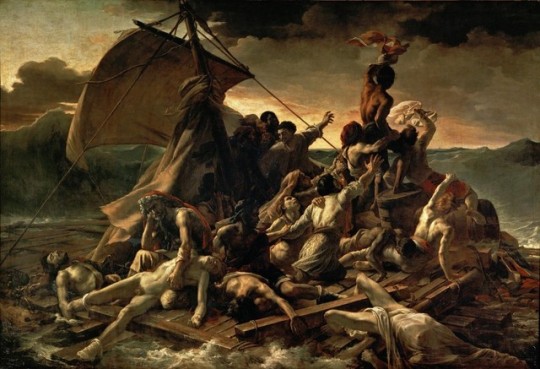
Okay, can we talk about this painting? It’s both historically interesting and Hannibal relevant, so something for everyone!
This is Le Radeau de la Méduse (The Raft of the Medusa), and the original was painted by Theodore Géricault in 1819. It’s a depiction of the aftermath of a colossal fuck up that took place three years earlier. The painting itself is massive - the figures in the foreground are twice life-size, to give you an idea of the scale. If you stand in front of the painting, you’re in the painting. It’s in the Louvre if you ever want to see it in person.
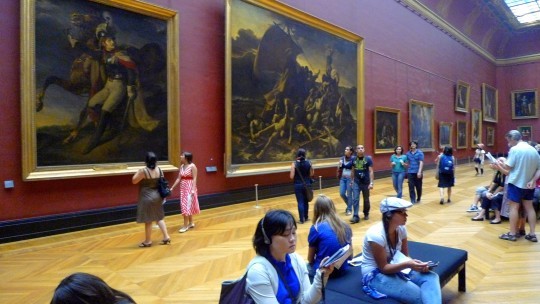
Hannibal Lecter’s version is much smaller.
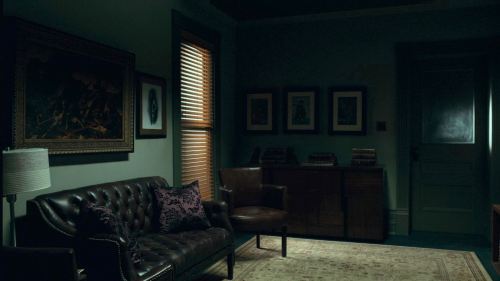
The frigate Méduse was stranded in shallow water by a series of shitty sailing decisions by a very bad captain, about thirty-five miles from shore near Mauritania. The crew built a raft they called la Machine to put all the cargo on to try and lighten the ship enough to float it - but the ship started to break up in bad weather, so everyone panicked and all but 17 people out of 400 decided to make a run for it.
There were 6 boats, which held about 40 people each, leaving 145 men and one woman to cram onto a 20x60 foot raft that had not been designed or stocked to carry people. They had one bag of biscuits, two barrels of water, and six casks of wine. The raft sank below the level of the water pretty much immediately and stayed that way, with the majority of the deck under the surface, so everyone on board was stuck in the water or fighting for drier spots, and all constantly terrified they were going to sink further.
It got worse.
The boats were supposed to tow the raft to safety, but after a few miles they decided to cut the raft loose and abandon almost half their shipmates and passengers. The people on the raft ran out of biscuits on day one, and the water was lost overboard when fighting broke out. 20 people died on day one, mostly either murdered or suicide. Many people died fighting over primo territory at the center of the raft, and many others were swept into the ocean by waves since most of the raft was still underwater and the weather was awful.
By day 4 there were less than 70 people alive, but on the plus side food wasn’t really an issue anymore since there were all these dead bodies around. On day 8, there was one last big fight and 15 guys threw everyone else overboard.
The people who made it into the boats - the ones who cut the raft loose on day one - all made it safely to the coast. A few died on the overland journey, but most of them made it home safe and sound, including the incompetent, politically appointed officer who got them all stranded in the first place. No one was sent to look for the rest of the survivors.
On day 13 the survivors on the raft saw a ship in the distance and tried to signal it, but it passed them by. That’s the moment depicted in the painting, by the way. The moment riiiiight before they realized they weren’t getting rescued. Fun times, right? The ship turned out to be the Argus, name after a Greek mythological figure with 100 eyeballs, so ha ha, good name choice. They spotted it again a few hours later and this time the last 15 survivors were rescued. Five of them died a few days after making it to land. France had no interest in helping the last 10 guys get home, so the British Navy took them back to France instead.
One of the survivors was the ship’s surgeon (somebody give me this historical AU please? I am just imagining Hannibal literally drinking wine on a pile of corpses in the one dry spot on the raft while the sharks circle), who filed a report on the whole mess that got the captain brought up on trial. He got 3 years prison time, but not until after he mounted an expedition to go back for the cargo (including gold) the Méduse had been carrying. When they arrived at the wreck site 54 days later, 3 of the 17 people they’d left behind on the ship were still alive despite everyone taking their sweet fucking time. One of the other survivors wrote a very political book about it, and the general scandal of the whole thing resulted in laws being passed in France that military promotions had to be based on merit instead of politics.
Géricault heard the story of the wreck and its aftermath (it was pretty big news especially once the books and trials and such started up). He became absolutely obsessed with it. He interviewed survivors and got them to pose for him, and ultimately spent three years working on the project and did tons of sketches and drafts and preliminary paintings, many of which could have carried titles like Still Life With Pile Of Severed Limbs.
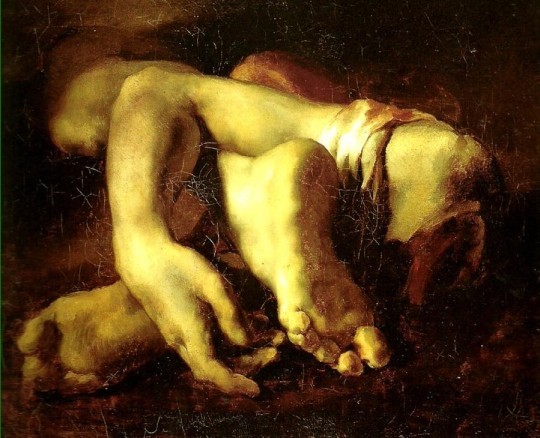
He would go sit in the morgue and draw dead people, poking and moving them around to see how stiff limbs moved and dead skin changed color in the light. He set up his studio across the street from the hospital so he’d have access to the morgue. He sat in with dying patients trying to capture their expressions as they suffered and died.
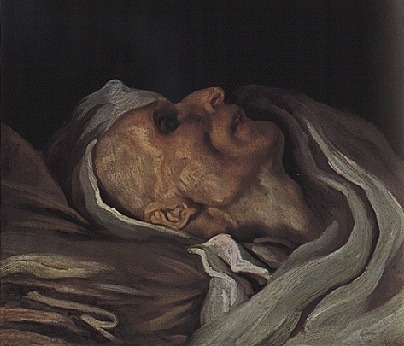
Gericault picked up severed heads from insane asylums and executions and kept them in his studio (where he also lived) so he could paint them over and over. He interviewed the Méduse’s surgeon (com’mon, y’all, can’t you see the historical fusion fanfic buried here?) and even got the ship’s carpenter to build him a replica of the raft.
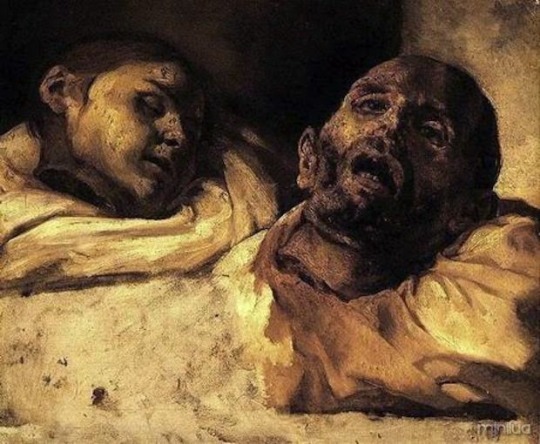

Le Radeau de la Méduse even contains a cannibalism joke pulled from Dante’s Inferno. The old man with his son across his lap, in the foreground, is supposed to represent Ugolino della Gherardesca, who was locked in a tower with his family and left to starve and supposedly ate his own children. Dante met him in hell still gnawing on his enemy’s brain. Oh, and William Blake did a painting of him (though the one Géricault used as a reference is by Henry Fuseli).
Y’all, this is the most Hannibal painting ever painted. The only thing missing is an ominous spectral deer. And you know how it came to my attention? THIS PAINTING IS HANGING IN HANNIBAL LECTER’S WAITING ROOM. That’s right. If you go to Dr. Lecter’s office for therapy, this is what you get to stare at while you wait your turn. Because he’s subtle like that.
Never change, Hannibal. Never change.
#tw: gore#hannibal#theodore gericault#art history for fannibals#set design#someone make me fic where Will is Gericault and Hannibal is the surgeon#I will love you forever
1K notes
·
View notes